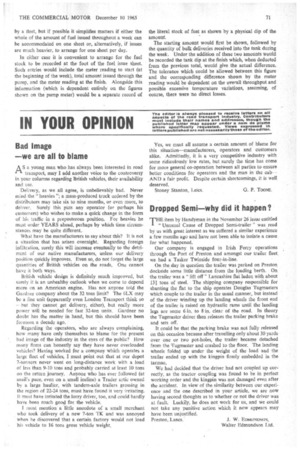IN YOUR OPINION
Page 73

If you've noticed an error in this article please click here to report it so we can fix it.
Bad Image —we are all to blame
Asa young man who has always been interested in road transport, may I add another voice to the controversy in your columns regarding British vehicles, their availability and use.
Delivery, as we all agree, is unbelievably bad. Never mind the "heavies "; a mass-produced truck ordered by the distributors may take six to nine months, or even more, to deliver. Surely this puts any operator (or perhaps his customers) who wishes to make a quick change in the form of his traffic in a preposterous position. For heavies he must order YEARS ahead, perhaps by which time circumstances may be quite different.
What have the manufacturers to say about this? It is not a situation that has arisen overnight. Regarding foreign infiltration, surely this will increase eventually to the detriment of our native manufacturers, unless our delivery position quickly improves. Even so, do not forget the large quantities of British vehicles on the roads, One cannot have it both ways.
British vehicle design is definitely much improved, but surely it is an unhealthy outlook when we come to depend more on an American engine. Has not anyone told the Gardner company about the 32 tons limit? The 6LX may be a fine unit (apparently even London Transport think so but they cannot get delivery, either), but really more power will be needed for fast 32-ton units. Gardner no doubt has the matter in hand, but this should have been foreseen a decade ago.
Regarding the operators, who are always complaining, how many have only themselves to blame for the present bad image of the industry in the eyes of the public? How many firms can honestly say they have never overloaded vehicles? Having worked for a company which operates a large fleet of vehicles, I must point out that at our depot 7-tonners never went on long-distance work with a load of less than 9-10 tons and probably carried at least 10 tons on the return journey. Anyone who has ever followed (at snail's pace, even on a small incline) a Trader artic owned by a large haulier, with tandem-axle trailers grossing in the region of 22-24 tons, must have found it very irritating. It must have irritated the lorry driver, too, and could hardly have been much good for the vehicle.
I must mention a little anecdote of a small merchant who took delivery of a new 7-ton TK and was annoyed when he discovered that a certain factory would not load his vehicle to 16 tons gross vehicle weight. Yes, we must all assume a certain amount of blame for this situation—manufacturers, operators and customers alike. Admittedly, it is a very competitive industry with some ridiculously low rates, but surely the time has come for more general co-operation between all parties to ensure better conditions for operators and the man in the cab— AND a fair profit. Despite certain shortcomings, it is well deserved.
Stoney Stanton, Leics. G. P. TOONE.




























































































































